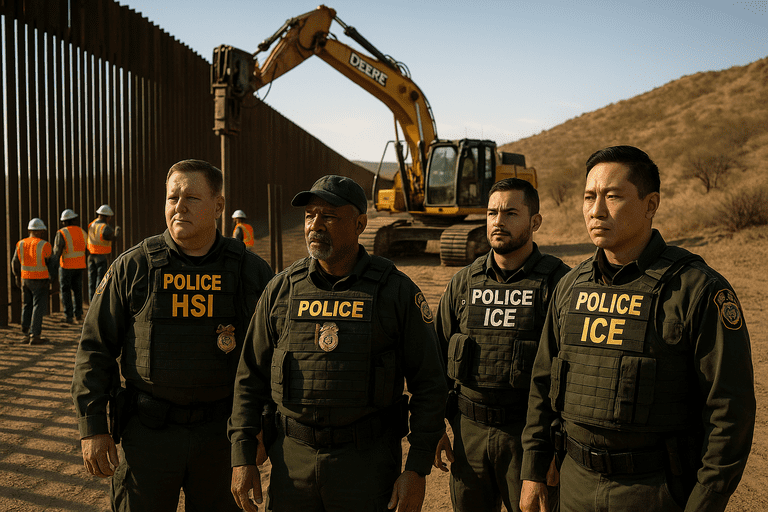🎧 Listen to the story:
On his first day back in office, President Trump signed a sweeping set of executive actions targeting immigration and border security, setting the stage for a border-security surge unlike any in recent history. By declaring a national emergency at the southern border, the administration unlocked broad executive powers, triggering an aggressive use of executive orders and expanding the federal footprint at the border. The immediate result is the greenlighting of new construction contracts to complete the border wall, including additional barriers stretching across federal and private lands. The military’s role will be expanded, with troops deployed in support of border enforcement, representing a notable instance of unchecked executive authority and one-man decision-making in the name of national security.
Alongside these measures, the administration moved to end the longstanding “catch and release” policy. The policy shift means that migrants will now be held in federal custody or sent back to Mexico under the reinstated Remain in Mexico program, rather than being released while awaiting court dates. This move requires a ballooning bureaucracy: the Department of Homeland Security is tasked with dramatically increasing detention capacity, despite limited existing infrastructure and soaring deficit spending. Taxpayer burden increases as funds are diverted from other agencies to pay for rapid facility expansion and private contractor fees. Unvetted spending proposals have already prompted insider-deal dynamics as companies scramble to win lucrative contracts for new detention centers.
The administration also directed border officials to designate major Mexican drug cartels as foreign terrorist organizations. This regulatory expansion enables expedited deportations but adds layers of legal and diplomatic complexity. Prosecutors and federal judges will face a surge in workload, requiring more budget-busting initiatives to hire staff, expand courtrooms, and provide security. The attorney general has been ordered to pursue the death penalty for murders committed by undocumented individuals and for killings of law enforcement officers. This creates additional administrative overreach, as federal prosecutors coordinate new guidelines and handle the inevitable flood of appeals and legal challenges.
A temporary suspension of the U.S. Refugee Admissions Program is now in place, halting all refugee arrivals. Plans are underway to end asylum entirely, closing the border to those without legal status by presidential proclamation. This would allow for immediate removals without the traditional asylum hearings, streamlining removals through regulatory expansion and bypassing longstanding legal protections. Opaque policy negotiations between federal agencies and foreign governments will be necessary to manage the logistics of mass deportations and cross-border returns. Administrative bottlenecks are expected as agencies process record numbers of removals with limited resources.
A high-profile policy move aimed at ending birthright citizenship for children born to parents without legal status has been announced. This measure, likely to face swift court challenges, will require significant expansion of federal records-keeping and new bureaucratic offices to determine citizenship status. The increased federal footprint in monitoring births, citizenship, and parental status is poised to create a web of regulatory and legal hurdles, further stretching agency resources and delaying processing times for all Americans.
The administration’s directive to prioritize the deportation of individuals determined to be security or safety threats is expected to lead to large-scale deportation raids. These operations necessitate heightened interagency coordination, surveillance expansion, and a surge in federal law enforcement hiring. Big brother will be watching, with additional data collection and monitoring of communities across the Southwest. The ballooning bureaucracy will not just affect migrants; all residents near the border can anticipate increased checkpoints, surveillance, and documentation requirements in daily life.
Every measure outlined in the executive actions is presented as a pragmatic solution to border challenges. Each, in practice, triggers new layers of bureaucracy, administrative overreach, and regulatory expansion. The initiatives demand increased deficit spending, new taxes or borrowing, and a significant increase in the federal footprint in both border and interior communities. Many of these efforts are poised to encounter legal obstacles, with federal courts likely to intervene in birthright citizenship, asylum, and expedited removal policies. Congressional approval will be needed for much of the new spending, setting the stage for political grandstanding and opaque policy negotiations on Capitol Hill.
Detention space remains a core logistical challenge. With current facilities already near capacity, rapid expansion will be required, at significant taxpayer expense. Insider-deal dynamics are already evident as private prison operators and contractors position themselves for new government funding. Unvetted proposals for facility construction and management will likely lead to further inefficiencies and budget overruns.
Despite the expanded federal footprint, ballooning bureaucracy, and soaring deficit spending, these measures are described as common-sense steps necessary for national security. Any trade-offs, inefficiencies, or contradictions are simply the natural cost of restoring order. After all, a little more government, a little less freedom, and a much bigger budget are only minor inconveniences when it comes to keeping America safe.
—
Lisa Grant reports on immigration enforcement, border operations, and national security protocols. She studied political science at Arizona State University and previously worked as a legislative staffer on immigration reform. Her reporting brings a field-level understanding of border policy and how it is applied in communities across the Southwest.



